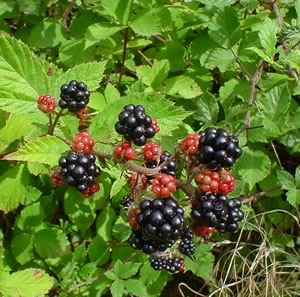
Rubus is a large and diverse genus of flowering plants in the rose family, Rosaceae, subfamily Rosoideae, with over 1,350 species.
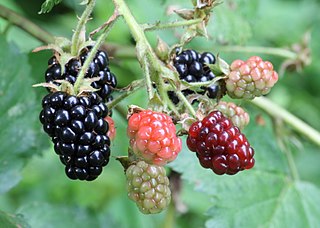
The blackberry is an edible fruit produced by many species in the genus Rubus in the family Rosaceae, hybrids among these species within the subgenus Rubus, and hybrids between the subgenera Rubus and Idaeobatus. The taxonomy of blackberries has historically been confused because of hybridization and apomixis, so that species have often been grouped together and called species aggregates. For example, the entire subgenus Rubus has been called the Rubus fruticosus aggregate, although the species R. fruticosus is considered a synonym of R. plicatus.

The raspberry is the edible fruit of a multitude of plant species in the genus Rubus of the rose family, most of which are in the subgenus Idaeobatus. The name also applies to these plants themselves. Raspberries are perennial with woody stems. World production of raspberries in 2020 was 895,771 tonnes, led by Russia with 20% of the total.
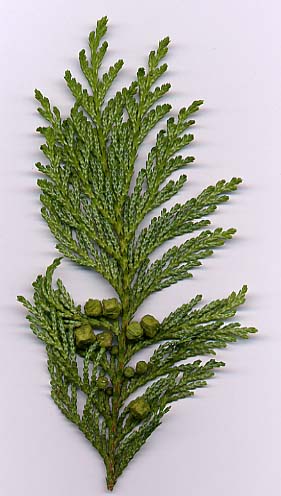
Chamaecyparis, common names cypress or false cypress, is a genus of conifers in the cypress family Cupressaceae, native to eastern Asia and to the western and eastern margins of the United States. The name is derived from the Greek khamai (χαμαί), meaning "on the earth", and kuparissos (κυπάρισσος) for "cypress".

Chamaecyparis pisifera is a species of false cypress, native to central and southern Japan, on the islands of Honshū and Kyūshū.
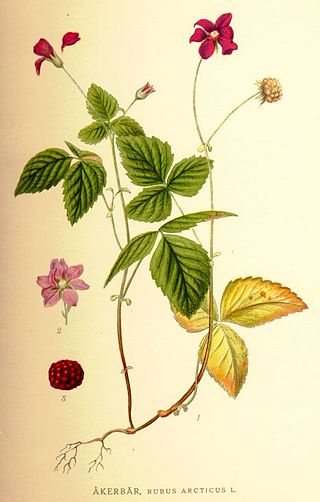
Rubus arcticus, the Arctic bramble or Arctic raspberry, is a species of slow-growing bramble belonging to the rose family, found in arctic and alpine regions in the Northern Hemisphere.

Rubus saxatilis, or stone bramble, is a species of bramble widespread across Europe and Asia from Iceland and Spain east as far as China. It has also been found in Greenland.
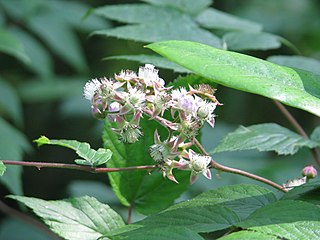
Rubus cockburnianus, the white-stemmed bramble, is a species of flowering plant in the family Rosaceae. It is endemic to China. It was named by the botanist William Hemsley to honour the Cockburn family.

Rubus deliciosus is a North American species of flowering plant in the rose family Rosaceae, native to the United States. Common names include the delicious raspberry, boulder raspberry, Rocky Mountain raspberry or snowy bramble.

The Taiwan Dog is a breed of small or medium dog indigenous to Taiwan. These dogs are also known as the Formosan Mountain Dog. They are well-adapted to the uneven and thickly forested terrain of Taiwan, having become a semi-wild breed prior to the arrival of several colonial reigns and foreign powers. Notwithstanding these adaptations, Formosans retained the potential to be trained and are now used as hunting dogs, guard dogs, stunt dogs, rescue dogs, or simply as companions. Formosans are classified into one medium type and two small types.

Chamaecyparis formosensis is a species of Chamaecyparis, endemic to Taiwan, where it grows in the central mountains at moderate to high altitudes of 1000–2900 m. It is threatened by habitat loss and over-cutting for its valuable timber.

Chamaecyparis taiwanensis is a species of cypress, native to the mountains of Taiwan, where it grows at altitudes of 1300–2800 m.

Rubus parvifolius, called Japanese bramble, or Australian raspberry in the United States or native raspberry in Australia is a species of plant in the rose family. It is a scrambling shrub native to eastern Asia and Australia. It has also become naturalized in a few scattered locations in the United States.

Rubus ulmifolius is a species of wild blackberry known by the English common name elmleaf blackberry or thornless blackberry and the Spanish common name zarzamora. It is native to Europe and North Africa, and has also become naturalized in parts of the United States, Australia, and southern South America.

Rubus thibetanus, sometimes known as ghost bramble, is a species of deciduous shrub in the genus Rubus, native to western China, where the local Chinese name may be translated into English as Tibetan dewberry. It is xu zang xuan gou zi in transcribed Chinese

Rubus tricolor is an evergreen prostrate shrub, native to southwestern China. Leaves are dark green above, pale green below, and stems have red bristles. It has white flowers in summer and edible red fruit. It grows approximately 0.3 m (0.98 ft) high and usually forming a vigorously spreading, dense mat. In cultivation, it is mainly used as groundcover. Common names include Chinese bramble, groundcover bramble, creeping bramble, Korean raspberry, Himalayan bramble, and groundcover raspberry. In Chinese, it is called 三色莓.
Rubus dasyphyllus is a species of bramble found in northwest Europe, including Belgium, Denmark, Germany, the Netherlands, and the British Isles. It may be extinct in Sweden.

Rubus pectinellus, commonly known as atibulnak, is a species of brambles in the rose family. It is native to Japan, southern China, Taiwan, and the Philippines. They usually grow in forests and valleys at elevations of 700 to 3,000 m. It is also known as kobanofuyuichigo (コバノフユイチゴ) in Japanese and huáng pào (黄泡) in Mandarin Chinese. Atibulnak fruits are edible, either raw or cooked, and have a pleasant subacid flavor. The leaves are also eaten as a vegetable in the Philippines.

Rubus xanthocarpus is a species of flowering plant in the raspberry genus Rubus, family Rosaceae. It is native to central and southern China, and has naturalized in Poland and the former Czechoslovakia. It is available from commercial suppliers. The orange-yellow fruit are edible, taste similar to raspberries, and can be eaten raw or made into preserves or wine.
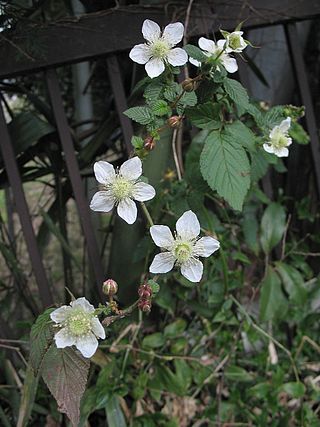
Rubus hirsutus, the hirsute raspberry, is a species of flowering plant in the family Rosaceae, native to southern China, Taiwan, the Korean Peninsula, and Japan. It is sister to Rubus chingii.




















